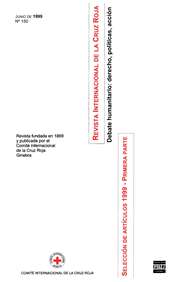No CrossRef data available.
Article contents
La aplicación del nuevo derecho humanitario
Published online by Cambridge University Press: 29 January 2010
Extract
La Conferencia Diplomática sobre la reafirmación y el desarrollo del derecho internacional humanitario aplicable en los conflictos armados tuvo lugar, de 1974 a 1977, en Ginebra. En su cuarto período de sesiones, el año 1977, aprobó dos Protocolos adicionales a los Convenios de Ginebra del 12 de agosto de 1949 relativos a la protección de las víctimas de los conflictos armados: el Protocolo I, relativo a los conflictos internacionales, y el Protocolo II, relativo a los conflictos no internacionales.
Poco después de haberse aprobado los Convenios de Ginebra en 1949, el Comité Internacional de la Cruz Roja (CICR) se dispuso a desarrollar esos instrumentos.
- Type
- Research Article
- Information
- Copyright
- Copyright © International Committee of the Red Cross 1980
References
page 185 note 1 A, Lombardi.: Bürgerkrieg und Völkerrecht, Duncker & Humblot, Berlin, 1976, pags. 25 y siguientesGoogle Scholar.
page 187 note 1 Pictet, Jean: Commentaire aux Conventions de Genève (I), CICR, Ginebra, 1952, págs. 43–48Google Scholar.
page 188 note 1 Report of the UN Secretary-General: Respect for Human Rights in Armed Conflicts, 1970, A/8025, para 158Google Scholar. « … But, even in such cases, the Government concerned and/or the other parties had not infregently denied the applicability of article 3, claiming that only national law applied to those situations.»
page 188 note 2 Pictet, J., Humanitarian Law and the Protection of War Victims, Sijthof, Leyden, 1975, pág. 19Google Scholar.
page 189 note 1 Yearbook of the UN Internacional Law Commission, 1966 vol. II, págs. 247–249Google Scholar.
page 190 note 1 Report of the UN Secretary-General, op. cit., 1970, A/8052, para. 135Google Scholar: «At the 1969 meeting of a Committee of Experts of the Internacional Committee of the Red Cross, it was generally agreed that foreign military intervention, on the side of either party, could transform an internal conflict into an international one, calling for the application of the laws and customs of war.»


